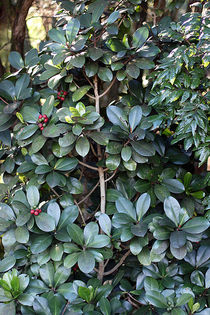
Elingamita johnsonii
Elingamita is a genus in the Myrsinaceae family of plants. It consists of a single species, Elingamita johnsonii, a tree or shrub endemic to the Three Kings Islands approximately 55 km north of the North Island of New Zealand. The entire world population of the tree is confined to a small rocky island and two nearby islets, and thus is vulnerable to destruction by fire or other unforeseen events. Elingamita johnsonii grows as a shrub or small tree in P?hutukawa forest and coastal scrub on West island. It also occurs on two rocky islets of the Princes Group; on one of these islets, Hinemoa Rock, it grows as an emergent canopy tree in exposed places. The relationship of Elingamita to other genera of the Myrsinaceae remains to be properly established. Discovered in 1950, Elingamita johnsonii takes its name from the steamer Elingamite, which was wrecked on West Island in 1902. The natural range is currently free of rodents, but the fruit is known to be very palatable to rats.Discovered in 1950, Elingamita johnsonii takes its name from the steamer 'Elingamite', which was wrecked on West Island in 1902. The natural range is currently free of rodents, but the fruit is known to be very palatable to rats. Description - The distinctive red fleshy fruits of Elingamita johnsonii take a year to ripen Elingamita johnsonii is a stoutly branched tree up to 8 m tall, but usually much less than that. More
